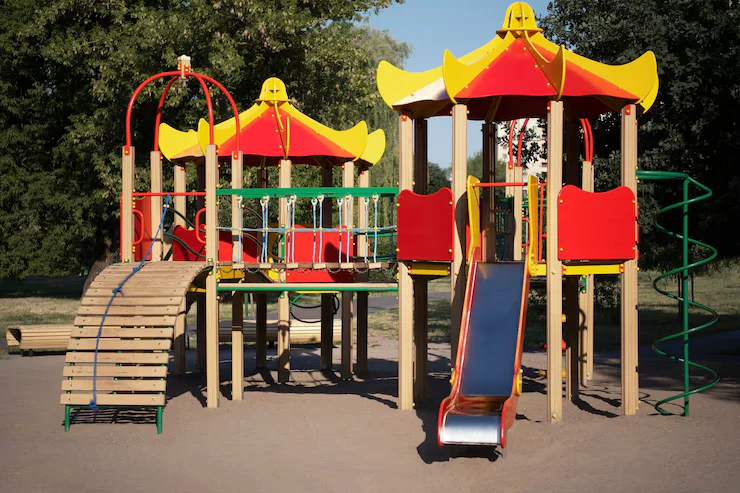The essence of a modern playground is not just to provide a space for children to exert their physical energy, but also to stimulate their imaginations, encourage social interaction, and contribute to their overall development. As urban spaces become more compact and childhood becomes increasingly digitised, the need for innovative children’s playground equipment that meets the evolutions in both social and environmental landscapes has never been more pressing.
Understanding the Role of Play in Child Development
Play is fundamental to children’s development, offering more than just recreation. Through play, children learn to interact with their environment, develop cognitive skills, and build social relationships. Innovative playground equipment must therefore cater to these developmental needs while offering safety and inclusivity.
Designing for Safety and Accessibility
Safety is the cornerstone of any playground design. The incorporation of soft fall materials, rounded edges, and equipment that adheres to stringent safety standards ensures that playgrounds are a safe space for children to explore and play. Furthermore, inclusive playground design takes into account the needs of all children, including those with physical or sensory disabilities, ensuring every child can enjoy the play space.
Integrating Nature into Playground Spaces
Incorporating natural elements into playground designs can create a seamless blend of natural exploration and structured play. Natural playgrounds that use materials such as wood, stone, and plants encourage children to interact with the environment, fostering a sense of connection to the natural world.
Forward-Thinking Equipment Designs
Today’s children’s playground equipment reflects the changing needs and expectations of modern families and communities. From multi-sensory elements to interactive and digital features, playground equipment must both excite and challenge young users.
Multi-Sensory Play Experiences
Multi-sensory playground equipment is designed to stimulate all five senses. Sound play elements, textured surfaces, vibrant colours, and varied shapes can enrich the sensory experience of a child, aiding their cognitive development and sensory processing skills.
Technology Integration
The introduction of technology into playground equipment can provide an interactive experience that bridges the gap between physical play and digital learning. Interactive panels and games that require physical movement to play can offer a balance between the benefits of technology and the importance of physical activity.
Themed Playground Equipment
Themed playgrounds can enhance imaginative play, with equipment designed around certain motifs or stories. Whether it’s a pirate ship, a castle, or a jungle adventure, themed playgrounds can transport children to different worlds, enhancing the play experience and fostering creativity.
Community and Environmentally Friendly Playgrounds
Modern playgrounds are also designed with community and environmental considerations in mind. By choosing sustainable materials and environmentally friendly manufacturing processes, playground equipment can lower its ecological footprint while promoting messages of sustainability to the next generation.
Fostering Social Interaction
Playground equipment should encourage children to play together, fostering social skills such as sharing, cooperation, and communication. Equipment that requires teamwork, such as see-saws or collaborative puzzles, can help children learn the value of working together.
Embracing Inclusivity in Design
Inclusive playground design goes beyond accessibility to ensure that children of all abilities can interact with the playground equipment. Adapted swings, wheelchair-accessible play structures, and sensory-rich elements provide a play environment where all children feel welcomed and included.
Stimulating Physical Development
Physical play is crucial for children’s health and development. Equipment that promotes climbing, jumping, balancing, and crawling helps to develop motor skills while providing the physical exercise that children need to stay healthy.
Adaptable and Modular Equipment
Modular playground equipment allows spaces to be customized for the specific needs of a community or to adapt to changes over time. This flexibility means that playgrounds can evolve with the needs of the children who use them, always providing a relevant and stimulating play experience.
Safe and Durable Materials
The choice of materials in playground equipment is critical not only for safety but also for longevity. Highly durable materials that can withstand the elements and the rigours of play ensure that playground investments are sound and sustainable over time.
Considering the Urban Context
In dense urban environments, playgrounds often need to integrate into smaller or irregularly-shaped spaces. Innovative design solutions are required to maximise play value while fitting within the parameters of limited urban spaces.
Conclusion: The Future of Playground Equipment
The landscape of play is ever-changing, shaped by advancements in safety, inclusivity, technology, and environmental concerns. Designers of children’s playground equipment must take a visionary approach to meet these evolving demands. By creating play spaces that are safe, inclusive, stimulating, and adaptable, we can ensure that our modern playgrounds continue to offer valuable experiences for the children of today and the generations to come.
Designing a playground is no small task, but the benefits of a well-thought-out space are immeasurable. The joy, learning, and growth that happen in these environments are a critical part of childhood, making the innovation of children’s playground equipment one of the vital components in shaping healthy, happy, and well-rounded individuals.







